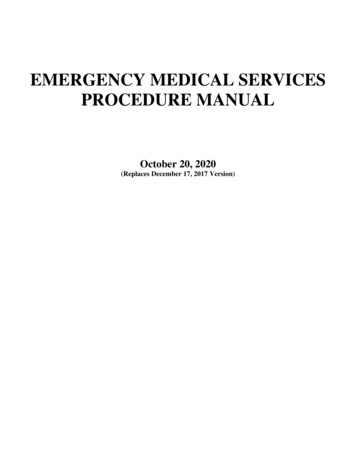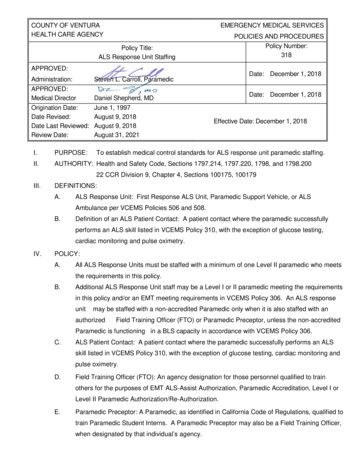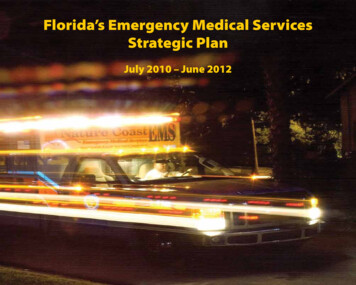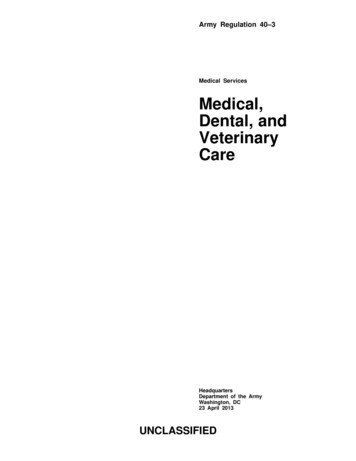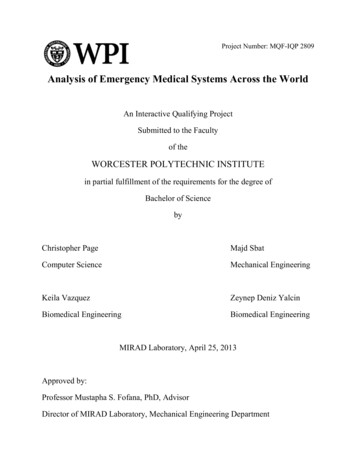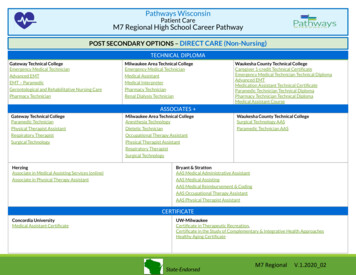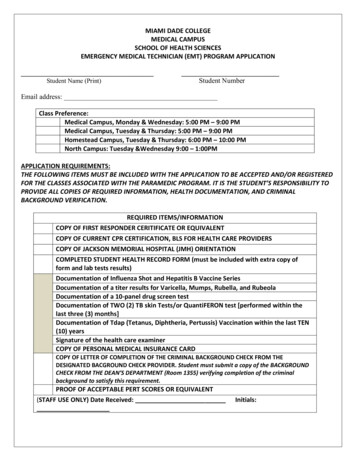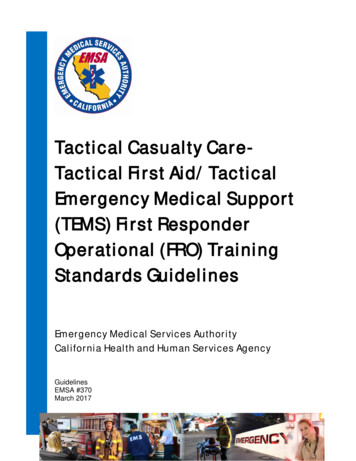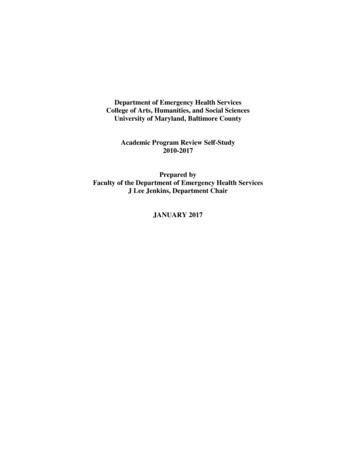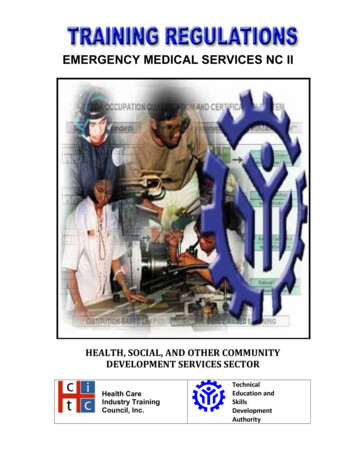
Transcription
EMERGENCY MEDICAL SERVICES NC IIHEALTH, SOCIAL, AND OTHER COMMUNITYDEVELOPMENT SERVICES SECTORHealth CareIndustry TrainingCouncil, Inc.TechnicalEducation andSkillsDevelopmentAuthority
Technical Education and Skills Development Act of 1994(Republic Act No. 7796)Section 22, “Establishment and Administration of the NationalTrade Skills Standards” of the RA 7796 known as the TESDA Actmandates TESDA to establish national occupational skillstandards. The Authority shall develop and implement acertification and accreditation program in which private industrygroup and trade associations are accredited to conduct approvedtrade tests, and the local government units to promote such tradetesting activities in their respective areas in accordance with theguidelines to be set by the Authority.TR-Emergency Medical Services (Ambulance Care Assistant) NC IIIPromulgated and Reviewed May 201394
TABLE OF CONTENTSHEALTH, SOCIAL AND OTHER COMMUNITYDEVELOPMENT SERVICES SECTOREMERGENCY MEDICAL SERVICES NC IIPage No.SECTION 1SECTION 2SECTION 3SECTION 4EMERGENCY MEDICAL SERVICESNC II QUALIFICATION1COMPETENCY STANDARD Basic Competencies Common Competencies Core Competencies2-1314-2627-76TRAINING STANDARDS3.1 Curriculum Design Basic Competencies Common Competencies Core Competencies3.2 Training Delivery3.3 Trainee Entry Requirements3.4 List of Tools, Equipment and Materials3.5 Training Facilities3.6 Trainers' Qualifications3.7 Institutional Assessment77-787980-82838484858585NATIONAL ASSESSMENT ANDCERTIFICATION ARRANGEMENTS86COMPETENCY MAP87DEFINITION OF TERMS88ACKNOWLEDGEMENTS89
TRAINING REGULATIONS FOREMERGENCY MEDICAL SERVICES NC IISECTION 1 EMERGENCY MEDICAL SERVICES NC II QUALIFICATIONThe EMERGENCY MEDICAL SERVICES NC II Qualification consists of competencies that aperson must achieve to perform cardiopulmonary resuscitation with automated externaldefibrillation operation, maintain life support equipment and resources, implement safe access andextrication procedures in an emergency, contribute in receiving request for ambulance service,contribute in allocating ambulance service resources, contribute in coordinating emergencyresources, deliver basic ambulance communication skills, contribute in on – road operations,contribute to emergency scene management, contribute to special event scene management,contribute to routine scene management, deliver pre- hospital patient care, contribute toambulance operations management, transport emergency patients, transport non- emergencypatients and drive ambulance under operational conditions.The Units of Competency comprising this Qualification include the following:UNIT CODEBASIC rticipate in workplace communicationWork in a team environmentPractice career professionalismPractice occupational health and safety proceduresUNIT CODECOMMON plement and monitor infection control policies and proceduresRespond effectively to difficult and challenging behaviorApply basic first aidMaintain high standard of patient servicesUNIT CODECORE 322316Perform Cardiopulmonary Resuscitation with AED OperationMaintain life support equipment and resourcesImplement safe access and extrication procedures in an emergencyContribute in receiving request for ambulance serviceContribute in allocating ambulance service resourcesContribute in coordinating emergency resourcesDeliver basic ambulance communication skillsContribute in on- road operationsContribute to emergency scene managementContribute to special event scene managementContribute to routine scene managementDeliver pre- hospital patient careContribute to ambulance operations managementTransport emergency patientsTransport non- emergency patientsDrive ambulance under operational conditionsA person who has achieved this Qualification is only competent to be the following and NOT as anEmergency Medical Technician (EMT): First-Aider Medical First Responder Ambulance Care AssistantTR-Emergency Medical Services NC II (Amended)Promulgated December 20131
SECTION 2 COMPETENCY STANDARDSThis section gives the details of the contents of the basic, common and core units ofcompetency required in EMERGENCY MEDICAL SERVICES NC II.BASIC COMPETENCIESUNIT OF COMPETENCY :PARTICIPATE IN WORKPLACE COMMUNICATIONUNIT CODE:500311105UNIT DESCRIPTOR:This unit covers the knowledge, skills and attitudes required togather, interpret and convey information in response to workplacerequirements.PERFORMANCE CRITERIAELEMENT1. Obtain and conveyworkplaceinformationItalicized terms are elaborated in the Range of Variables1.11.21.31.41.51.61.72. Participate inworkplace meetingsand discussions2.12.22.32.42.52.63. Complete relevantwork relateddocuments3.13.23.33.43.5Specific and relevant information is accessed fromappropriate sources.Effective questioning, active listening and speaking skills areused to gather and convey information.Appropriate medium is used to transfer information and ideas.Appropriate non- verbal communication is used.Appropriate lines of communication with supervisors andcolleagues are identified and followed.Defined workplace procedures for the location and storage ofinformation are used.Personal interaction is carried out clearly and concisely.Team meetings are attended on time.Own opinions are clearly expressed and those of others arelistened to without interruption.Meeting inputs are consistent with the meeting purpose andestablished protocols.Workplace interactions are conducted in a courteousmanner.Questions about simple routine workplace procedures andmaters concerning working conditions of employment areasked and responded to.Meetings outcomes are interpreted and implemented.Range of forms relating to conditions of employment iscompleted accurately and legibly.Workplace data is recorded on standard workplace forms anddocuments.Basic mathematical processes are used for routinecalculations.Errors in recording information on forms/ documents areidentified and properly acted upon.Reporting requirements to supervisor are completedaccording to organizational guidelines.TR-Emergency Medical Services NC II (Amended)Promulgated December 20132
RANGE OF VARIABLESVARIABLERANGE1. Appropriate sources1.1.1.2.1.3.1.4.1.5.Team membersSuppliersTrade personnelLocal governmentIndustry bodies2. ticeInformation discussionFollow-up or verbal instructionsFace to face communication3. Storage3.1.3.2.Manual filing systemComputer-based filing system4. Forms4.1.Personnel forms, telephone message forms, safety reports5. Workplaceinteractions5.1.5.2.5.3.5.4.Face to faceTelephoneElectronic and two way radioWritten including electronic, memos, instruction and forms,non-verbal including gestures, signals, signs and diagrams6. Protocols6.1.6.2.6.3.Observing meetingCompliance with meeting decisionsObeying meeting instructionsTR-Emergency Medical Services NC II (Amended)Promulgated December 20133
EVIDENCE GUIDE1. Critical aspects ofcompetencyAssessment requires evidence that the candidate:1.1. Prepared written communication following standard format ofthe organization.1.2. Accessed information using communication equipment.1.3. Made use of relevant terms as an aid to transfer informationeffectively.1.4. Conveyed information effectively adopting the formal orinformal communication.2. tive communicationDifferent modes of communicationWritten communicationOrganizational policiesCommunication procedures and systemsTechnology relevant to the enterprise and the individual’swork responsibilities3. Underpinning skills3.1.3.2.Follow simple spoken languagePerform routine workplace duties following simple writtennoticesParticipate in workplace meetings and discussionsComplete work related documentsEstimate, calculate and record routine workplace measuresBasic mathematical processes of addition, subtraction,division and multiplicationAbility to relate to people of social range in the workplaceGather and provide information in response to workplacerequirements3.3.3.4.3.5.3.6.3.7.3.8.4. ResourceimplicationsThe following resources MUST be provided:4.1. Fax machine4.2. Telephone4.3. Writing materials4.4. Internet5. Method ofassessmentCompetency MUST be assessed through:5.1. Direct Observation5.2. Oral interview and written test6. Context ofassessment6.1.Competency may be assessed individually in the actualworkplace or through accredited institutionTR-Emergency Medical Services NC II (Amended)Promulgated December 20134
UNIT OF COMPETENCY :WORK IN A TEAM ENVIRONMENTUNIT CODE:500311106UNIT DESCRIPTOR:This unit covers the skills, knowledge and attitudes to identify roleand responsibility as a member of a team.PERFORMANCE CRITERIAELEMENT1. Describe team roleand scopeItalicized terms are elaborated in the Range of Variables1.11.22. Identify own role andresponsibility withinteam2.12.22.33. Work as a teammember3.13.23.33.4The role and objective of the team is identified fromavailable sources of information.Team parameters, reporting relationships and responsibilitiesare identified from team discussions and appropriate externalsources.Individual role and responsibilities within the teamenvironment are identified.Roles and responsibility of other team members are identifiedand recognized.Reporting relationships within team and external to team areidentified.Effective and appropriate forms of communications used andinteractions undertaken with team members who contribute toknown team activities and objectives.Effective and appropriate contributions made to complementteam activities and objectives, based on individual skills andcompetencies and workplace context.Observed protocols in reporting using standard operatingprocedures.Contribute to the development of team work plans based onan understanding of team’s role and objectives and individualcompetencies of the members.TR-Emergency Medical Services NC II (Amended)Promulgated December 20135
RANGE OF VARIABLESVARIABLE1. Role and objective ofteamRANGE1.11.22. Sources ofinformation2.12.22.32.42.52.62.73. Workplace context3.13.23.33.43.5Work activities in a team environment with enterprise orspecific sectorLimited discretion, initiative and judgment maybedemonstrated on the job, either individually or in a teamenvironmentStandard operating and/or other workplace proceduresJob proceduresMachine/equipment manufacturer’s specifications andinstructionsOrganizational or external personnelClient/supplier instructionsQuality standardsOHS and environmental standardsWork procedures and practicesConditions of work environmentsLegislation and industrial agreementsStandard work practice including the storage, safe handlingand disposal of chemicalsSafety, environmental, housekeeping and quality guidelinesTR-Emergency Medical Services NC II (Amended)Promulgated December 20136
EVIDENCE GUIDE1. Critical aspects ofcompetencyAssessment requires evidence that the candidate:1.1Operated in a team to complete workplace activity1.2Worked effectively with others1.3Conveyed information in written or oral form1.4Selected and used appropriate workplace language1.5Followed designated work plan for the job1.6Reported outcomes2. Underpinningknowledge2.12.22.32.4Communication processTeam structureTeam rolesGroup planning and decision making3. Underpinning skills3.1Communicate appropriately, consistent with the culture of theworkplace4. ResourceimplicationsThe following resources MUST be provided:4.1Access to relevant workplace or appropriately simulatedenvironment where assessment can take place4.2 Materials relevant to the proposed activity or tasks5. Method ofassessmentCompetency may be assessed through:5.1Observation of the individual member in relation to the workactivities of the group5.2Observation of simulation and or role play involving theparticipation of individual member to the attainment oforganizational goal5.3 Case studies and scenarios as a basis for discussion ofissues and strategies in teamwork6. Context ofassessment6.16.2Competency may be assessed in workplace or in a simulatedworkplace settingAssessment shall be observed while task are beingundertaken whether individually or in groupTR-Emergency Medical Services NC II (Amended)Promulgated December 20137
UNIT OF COMPETENCY :PRACTICE CAREER PROFESSIONALISMUNIT CODE:500311107UNIT DESCRIPTOR:This unit covers the knowledge, skills and attitudes in promotingcareer growth and advancement.PERFORMANCE CRITERIAELEMENT1. Integrate personalobjectives withorganizational goalsItalicized terms are elaborated in the Range of Variables1.11.21.32. Set and meet workpriorities2.12.22.33. Maintain professionalgrowth anddevelopment3.13.23.3Personal growth and work plans are pursued towardsimproving the qualifications set for the profession.Intra and interpersonal relationships are maintained in thecourse of managing oneself based on performanceevaluation.Commitment to the organization and its goal is demonstratedin the performance of duties.Competing demands are prioritized to achieve personal, teamand organizational goals and objectives.Resources are utilized efficiently and effectively to managework priorities and commitments.Practices along economic use and maintenance of equipmentand facilities are followed as per established procedures.Trainings and career opportunities are identified andavailed of based on job requirements.Recognitions are sought/received and demonstrated as proofof career advancement.Licenses and/or certifications relevant to job and career areobtained and renewed.TR-Emergency Medical Services NC II (Amended)Promulgated December 20138
RANGE OF VARIABLESVARIABLERANGE1. Evaluation1.11.21.3Performance AppraisalPsychological ProfileAptitude Tests2. Resources2.12.22.3HumanFinancialTechnology2.3.1 Hardware2.3.2 Software3. Trainings and careeropportunities3.13.2Participation in training programs3.1.1 Technical3.1.2 Supervisory3.1.3 Managerial3.1.4 Continuing EducationServing as Resource Persons in conferences and workshops4. ionsCertificate of AppreciationsCommendationsAwardsTangible and Intangible Rewards5. Licenses and/orcertifications5.15.25.35.4National CertificatesCertificate of CompetencySupport Level LicensesProfessional LicensesTR-Emergency Medical Services NC II (Amended)Promulgated December 20139
EVIDENCE GUIDE1. Critical aspects ofcompetencyAssessment requires evidence that the candidate:1.1Attained job targets within key result areas (KRAs)1.2Maintained intra and interpersonal relationship in the course ofmanaging oneself based on performance evaluation1.3Completed trainings and career opportunities which are basedon the requirements of the industries1.4Acquired and maintained licenses and/or certificationsaccording to the requirement of the qualification2. Underpinningknowledge2.12.22.32.42.5Work values and ethics (Code of Conduct, Code of Ethics,etc.)Company policiesCompany operations, procedures and standardsFundamental rights at work including gender sensitivityPersonal hygiene practices3. Underpinning skills3.13.23.3Appropriate practice of personal hygieneIntra and Interpersonal skillsCommunication skills4. ResourceimplicationsThe following resources MUST be provided:4.1Workplace or assessment location4.2Case studies/scenarios5. Method ofassessmentCompetency may be assessed through:5.1Portfolio bservation5.5Third Party Reports5.6Exams and Tests6. Context ofassessment6.1Competency may be assessed in the work place or in asimulated work place settingTR-Emergency Medical Services NC II (Amended)Promulgated December 201310
UNIT OF COMPETENCY :PRACTICE OCCUPATIONAL HEALTH AND SAFETYPROCEDURESUNIT CODE:500311108UNIT DESCRIPTOR:This unit covers the outcomes required to comply with regulatoryand organizational requirements for occupational health and safety.PERFORMANCE CRITERIAELEMENT1. Identify hazards andrisksItalicized terms are elaborated in the Range of Variables1.11.21.32. Evaluate hazards and 2.1risks2.22.33. Control hazards andrisks3.13.23.33.44. Maintain OHSawareness4.14.2Safety regulations and workplace safety and hazard controlpractices and procedures are clarified and explained based onorganization procedures.Hazards/risks in the workplace and their correspondingindicators are identified to minimize or eliminate risk to coworkers, workplace and environment in accordance withorganization procedures.Contingency measures during workplace accidents, fire andother emergencies are recognized and established inaccordance with organization procedures.Terms of maximum tolerable limits which when exceeded willresult in harm or damage are identified based on thresholdlimit values (TLV).Effects of the hazards are determined.OHS issues and/or concerns and identified safety hazards arereported to designated personnel in accordance withworkplace requirements and relevant workplace OHSlegislation.Occupational Health and Safety (OHS) procedures forcontrolling hazards/risks in workplace are consistentlyfollowed.Procedures for dealing with workplace accidents, fire andemergencies are followed in accordance with organizationOHS policies.Personal protective equipment (PPE) is correctly used inaccordance with organization OHS procedures and practices.Appropriate assistance is provided in the event of a workplaceemergency in accordance with established organizationprotocol.Emergency-related drills and trainings are participated inas per established organization guidelines and procedures.OHS personal records are completed and updated inaccordance with workplace requirements.TR-Emergency Medical Services NC II (Amended)Promulgated December 201311
RANGE OF VARIABLESVARIABLE1. Safety regulations2. Hazards/Risks3. Contingencymeasures4. PPE5. Emergency-relateddrills and training6. OHS personalrecordsRANGEMay include but are not limited to:1.1Clean Air Act1.2Building code1.3National Electrical and Fire Safety Codes1.4Waste management statutes and rules1.5Philippine Occupational Safety and Health Standards1.6DOLE regulations on safety legal requirements1.7ECC regulationsMay include but are not limited to:2.1Physical hazards – impact, illumination, pressure, noise,vibration, temperature, radiation2.2Biological hazards- bacteria, viruses, plants, parasites, mites,molds, fungi, insects2.3Chemical hazards – dusts, fibers, mists, fumes, smoke,gasses, vapors2.4Ergonomics Psychological factors – over exertion/ excessive force,awkward/static positions, fatigue, direct pressure, varyingmetabolic cycles Physiological factors – monotony, personal relationship,work out cycleMay include but are not limited Calling designed) emergency personnelMay include but are not limited to:4.1Mask4.2Gloves4.3Goggles4.4Hair Net/cap/bonnet4.5Face mask/shield4.6Ear muffs4.7Apron/Gown/coverall/jump suit4.8Anti-static suits5.1Fire drill5.2Earthquake drill5.3Basic life support/CPR5.4First aid5.5Spillage control5.6Decontamination of chemical and toxic5.7Disaster preparedness/management6.1Medical/Health records6.2Incident reports6.3Accident reports6.4OHS-related training completedTR-Emergency Medical Services NC II (Amended)Promulgated December 201312
EVIDENCE GUIDE1. Critical aspects ofcompetency2. Underpinningknowledge3. Underpinningskills4. Resourceimplications5. Method ofassessment6. Context ofassessmentAssessment requires evidence that the candidate:1.1Explained clearly established workplace safety and hazardcontrol practices and procedures1.2Identified hazards/risks in the workplace and its correspondingindicators in accordance with company procedures1.3Recognized contingency measures during workplaceaccidents, fire and othe
TR -Emergency Medical Services (Ambulance Care Assistant) NC III Promulgated and Reviewed May 2013 94 . certification and acc reditation program in which private industry group and trade associations are accredited to conduct approved . ambulance operations management, transport emergency

